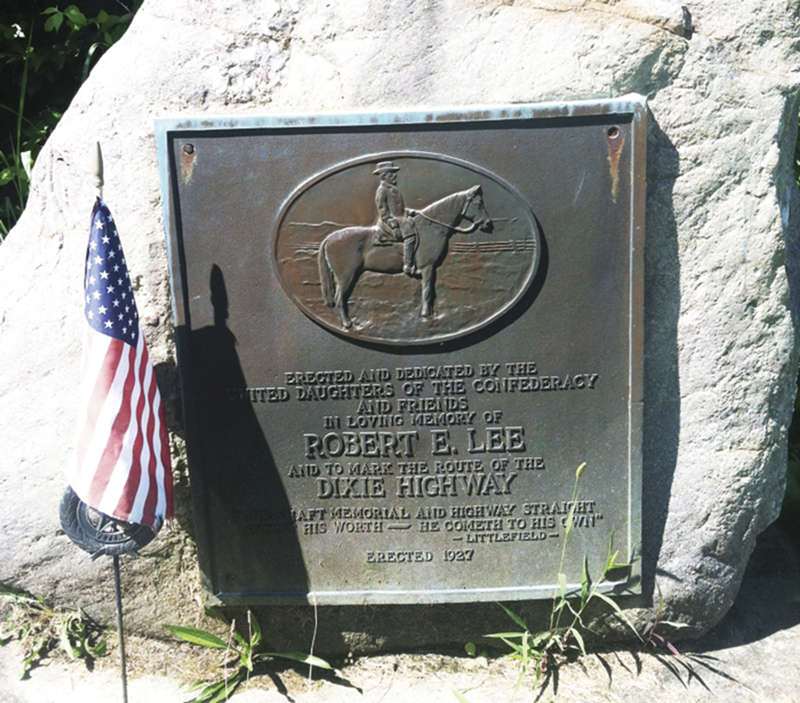War-related memorials and monuments are one of the most common forms of public art, and it will probably stay that way as long as there are wars to remember. But just because we have these everywhere, we shouldn’t take their existence for granted.
One of the strangest — not because of the way it looks, but because it exists at all — is the monument to General Robert E. Lee, commander of the Confederate armies, in southwest Ohio. Yes, Ohio — not only a loyal member of the United States during the Civil War, but also the home state of President Lincoln’s commanding general, Ulysses S. Grant (who was elected president himself). And also home to other Ohioan generals, who were instrumental in defeating the Confederate states, which had seceded from the United States primarily to maintain slavery.
If any state would seem to not have a need to honor Lee with a monument, it would be Ohio. Yet there it is, in a grassy area along the roadside just outside the city of Franklin, north of Cincinnati in northwest Warren County at the corner of the (old) Dixie Highway (old U.S. 25) and Hamilton-Middletown Road.
It is a large, ruggedly shaped boulder with a bronze plaque in the center, fenced off from the roadway by some petite white pillars and a draped metal chain. The plaque depicts Lee astride his horse, Traveller, and reads, “Erected and Dedicated by the United Daughters of the Confederacy and Friends In Loving Memory of Robert E. Lee and to Mark the Route of the Dixie Highway. ‘The shaft memorial and highway straight attest his worth — he cometh to his own.’ — Littlefield/Erected 1927.”
On my recent visit, the grass around the monument had been cut, and a small American flag was at the base. I had to park on the shoulder of the highway since there was no lot for stopping. Practically no one I talked to knew about it, other than those who study and document such things. (Franklin City Clerk Jane McGee, who said she had only learned about the Lee monument recently, said it appears to be on city property.)
In an online forum at American Road magazine, a contributor mentioned finding other Lee monuments that the United Daughters had placed along then-new national Dixie Highway routes. But Cindy Branam, president of the Ohio division of the United Daughters of the Confederacy, said she had never heard of the monument until a recent call from a blogger. Her research shows it appears to be one of three markers her group had installed in Ohio — the others acknowledge actual historic sites, Confederate cemeteries at Johnson’s Island and Columbus. She also supported a new one in Wellston, Ohio, near a battle site.
The Cincinnati Enquirer advanced the 1927 dedication ceremonies for the “marker,” noting that among those present would be the president of Ohio’s United Daughters of the Confederacy, Ohio’s director of highways, and — on behalf of the city — the publisher of the Franklin Chronicle. A male quartet would sing “Carry Me Back to Ole Virginny” (Lee’s home state was Virginia), an official from Virginia’s Washington and Lee University was to give an address, and the audience would sing Lee’s favorite hymn, “How Firm a Foundation."
This occurred in an era when entrepreneurs and others were interested in creating “national highways” to lure the growing number of motorists to new destinations. Earl Swift’s book The Big Roads tells how Carl Fisher came up with the Dixie Highway idea to promote his Miami Beach development with Midwesterners. So great was the demand by municipalities to be included on this highway, he devised two Midwestern routes to the South — one from Detroit through Cincinnati and Knoxville and another from Indianapolis through Nashville. Much of the routing followed a patchwork of existing roads.
The true irony and oddity about all this is that the monument is across the street from Woodhill Cemetery, which Franklin Township owns. And it has a true Civil War memorial — and a state historical marker — dedicated to area soldiers who fought and died for the Union in the Civil War. Twenty-one of them are buried in the cemetery.
In the book The History of Franklin in the Great Miami Valley, contributor Dorothy Scholl tells of the surprise many in the area felt when a motorist knocked the Lee monument off its foundation in 1981. Until the resultant news coverage, few had any idea what the monument was about as they zipped past it. Scholl talked to Judge J.T. Riley, a prominent resident, who said that Franklin businessman Barry Brown spurred the monument’s creation, in part because “Lee did as much as anyone to heal the wounds left by the fighting of the Civil War.”
If that’s the true purpose of it, and it wasn’t just a tie-in with a then-new highway to the South, it isn’t explained fully on the plaque. As recent tragic events in Charleston, S.C., have shown, those wounds haven’t completely healed yet. And there is a debate that perhaps there has been too much commemoration and not enough atonement for the Confederacy and what it stood for. That debate largely has been taking place in the South, but the presence of the Lee monument in Franklin means Ohio could benefit from it, too.
CONTACT STEVEN ROSEN: [email protected]






